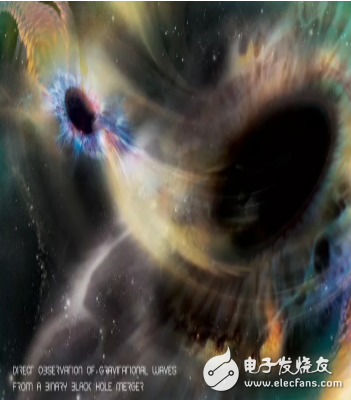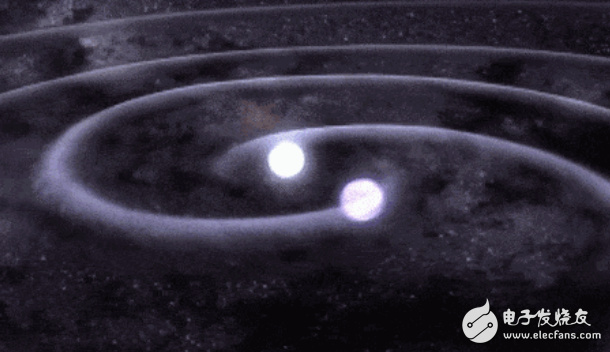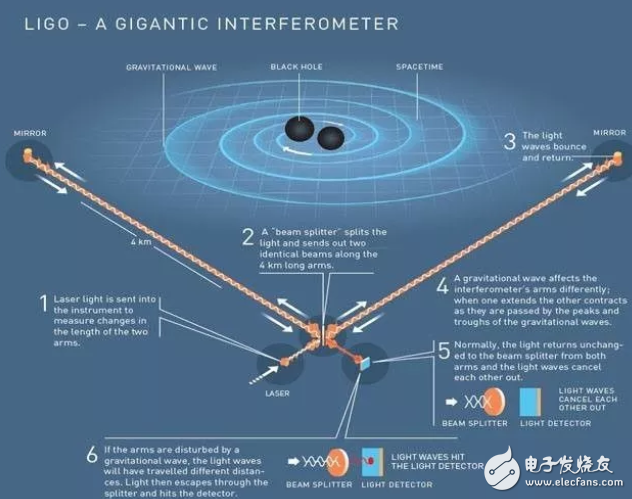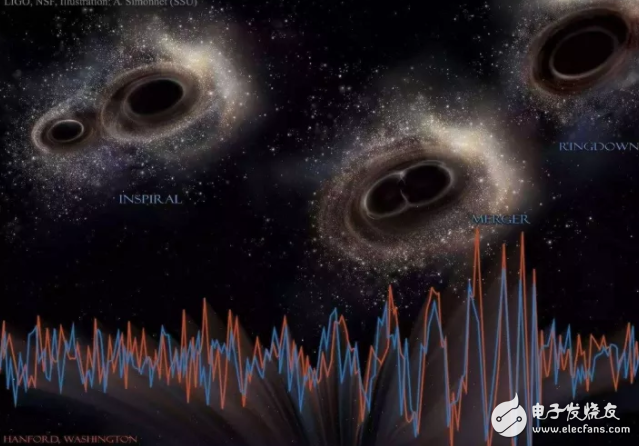AI technology is developing towards maturity, and the scope of use is constantly expanding, although we can still see the shadow of AI above space. It is reported that the popular "gravitational wave" in the astrophysics community is benefited from the advancement of AI technology. The latest gravitational wave signal was detected on August 14, 2017, resulting from the merger of double black holes. Artificial intelligence technology has long been used in space exploration, including computer vision, speech recognition, natural language processing, and machine learning. It has won the 2017 Nobel Prize in Physics for gravitational wave research and also uses AI technology to analyze data. Maybe in the future, we have to give the AI ​​a Nobel Prize? Nearly a century ago, Einstein predicted in the theory of relativity that there is fluctuation in the structure of time and space, that is, gravitational waves. Later, a group of scientists formed the "Laser Interference Gravitational Wave Observatory" (LIGO) project for the first time on September 14, 2015 to detect the gravitational wave signal of a double black hole system. At that time, it triggered a revolution in the astrophysics community. The team that participated in the discovery of gravitational waves was locked in by the Nobel Prize in Physics. After that, the scientific community detected the existence of gravitational waves three times. The most recent one was the United States "Laser Interference Gravitational Wave Observatory" (LIGO) and the European "Virgo" gravitational wave detector two project teams said in a statement, The latest gravitational wave signal was detected on August 14, 2017, similar to the previous three, and was created by the merger of double black holes. It is understood that these two black holes are about 1.8 billion light-years away from the Earth. The mass before the merger is equivalent to 31 and 25 suns respectively. The combined total mass is equivalent to 53 suns, and the mass of about 3 suns is converted into energy. The release of gravitational waves. Unsurprisingly, the 2017 Nobel Prize in Physics was finally awarded to the “gravitational wave†research team, including American scientists Reina Weiss, Barry Barish and Kip Thorne, in recognition of their “laser interferenceâ€. The Gravitational Wave Observatory" (LIGO) project and the discovery of the contribution of gravitational waves. For a time, "gravitational wave" has received attention from all walks of life, but what is gravitational wave? Simply put, this gravitational wave concept is derived from Einstein's general theory of relativity. We all know that relativity is always discussing the dialectical relationship between time and space and matter. The gravitational wave is that matter will cause time and space to bend and bend, while time and space The bending propagates outward from the radiation source in the form of waves. This wave transmits energy in the form of gravitational radiation, and its velocity is close to the speed of light. The extreme case is a black hole. The quality is too large, causing time and space distortion, and the light can't run and slip in. We have heard of water waves, sound waves, and electric waves. This is called gravitational waves. Because our mainstream basic physics science knowledge is based on Newton's theory of universal gravitation, any object has mutual attraction, and the magnitude of this force is proportional to the mass of each object. Einstein believes that this theory is superficial, further Studying the gravitation of what does not exist at all, the reason why the effect of gravity seems to be caused by the distortion of time and space. If the law of universal gravitation is wrong, is our current mainstream physics knowledge astray? This TM is very embarrassing, who is right or wrong to give scientists to further study. But then again, cosmological science research is now using more and more artificial intelligence analysis techniques, such as the detection and discovery of gravitational waves. The biggest challenge of capturing gravitational waves is that the sampling frequency of LIGO data is particularly high, reaching more than 16,000 times per second, with tens of thousands of sampling channels, and the amount of data is particularly large, using machine learning. Data processing methods can improve data processing efficiency." It is understood that the LIGO detector consists of 10 subsystems, one of which is Data and CompuTIngSystems (DSC). The data obtained by LIGO includes not only the data output from the laser interferometer gravitational wave detector, but also various independent detectors and recorders that monitor the environment of the detector and the state of the detector equipment, such as temperature, pressure, and wind. Monitoring of environmental conditions such as heavy rain, hail, surface vibration, sound, electric field, and magnetic field, as well as monitoring the state of the detector itself such as the position of the plane mirror and the lens inside the gravitational wave detector. In terms of data acquisition, for example at the primary LIGO Hanford Observatory, DAQ's H1 and H2 interferometers recorded a total of 12,733 channels, of which 1,279 were fast lanes (digital rate at 2048 Sa/sec or 16384 Sa/sec). The upgraded LIGO is designed to record data acquisitions greater than 300,000 channels, of which approximately 3,000 are fast lanes. This is a typical big data analysis and processing problem, which requires powerful computing resources and advanced algorithms to effectively handle such a huge amount of data. In the search for gravitational wave signals, matched filtering techniques are used. Matching filtering is a technique based on waveform analysis. It is required to establish a reasonable physical model for the gravitational wave source. Thousands of templates are generated according to the model. These templates are used to match the signals in the gravitational wave data to find related events. In addition, unlike telescopes, gravitational lenses distorted objects into fuzzy loops and arcs, so understanding is quite difficult, and applying artificial intelligence neural networks to the analysis of gravitational wave images will be faster than the original method. Ten million times, the neural network is able to discover new shots and determine their properties, mass distribution, and level of magnification of the background galaxies. Postdoctoral researcher Lawrence Perenad Levasel said, "Neural networks will help us identify interesting objects and analyze them quickly, which will give us more time to explore the universe." At present, artificial intelligence is applied to gravitational wave big data analysis and processing, at least several aspects are worthy of attention: 1 Supervised learning: The matched filter method needs to know the waveform of the signal. This gravitational wave strain data analysis is matched with the waveform in the massive waveform library. It is obviously a process with huge computational workload. How to improve the search efficiency and reduce the calculation The consumption of resources is undoubtedly worthy of further study. 2 Unsupervised learning: In gravitational wave detection, the waveforms of a large number of events are unknown. For supernovae and rotating neutron stars, the current astronomical observations cannot give a theoretical estimate of the gravitational wave intensity they release. This requires unsupervised Learn algorithms to discover unknown patterns in gravitational wave data. 3 Integrated learning strategy: The continuous gravitational waves other than the gravitational waves combined with the double black holes detected this time, the original gravitational waves and other types of gravitational waves have not been detected, such as continuous gravitational waves from rotating neutron stars, except In addition to the higher sensitivity requirements of the detector, the ability to analyze data is also highly demanding. Astronomical science research is too far away from ordinary people. Although there is no direct commercial value in studying gravitational wave data analysis technology, subsequent technology (algorithm) migration can be considered, and the development of big data analysis and processing technology can be applied to other commercial fields, or other academics. Research produces value. Gravitational wave data analysis mostly uses one-dimensional signal processing technology, which can be transferred to spectral data analysis, FAST detection data analysis, and EEG data analysis. In fact, artificial intelligence technology has long been used in space exploration, including computer vision, speech recognition, natural language processing, and machine learning. Detectors help us to obtain images, information, and data from the universe, and then transmit it back to Earth. Humans will enhance their ability to understand the universe, and then the role played by AI will become larger and larger. The exploration of AI technology by the exploration of space science will eventually benefit the entire human society. Just like the one you accidentally heard: If you look up at the stars, you will see an apple. If you see an apple, you will study its origin. If you study its origin, you will explore a law if you explore one. You will want a conclusion. If you want a conclusion, you will fall into a contradiction. If you fall into a conflict, you need to look up at the stars. Cosmic exploration, AI technology, and human society are probably such dialectical reincarnation relations. Such reincarnation also continually stimulates the continuous imagination and development momentum of human civilization. Flat Wire Power Inductors,Flat Copper Wire Inductors,Flat Coil High Current Inductors,Flat Wire High Power Inductors Shenzhen Sichuangge Magneto-electric Co. , Ltd , https://www.scginductor.com





